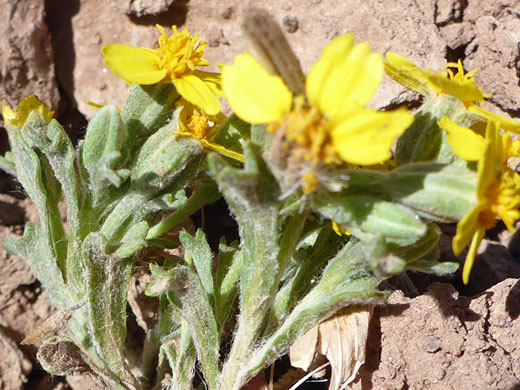Syntrichopappus Fremontii, Yellowray Fremont's-Gold
Plants > Wildflowers > Asteraceae > Syntrichopappus Fremontii

Two groups of yellow flowerheads; syntrichopappus fremontii, Anasazi Valley, Santa Clara River Reserve, Utah
Common names:
Yellowray fremont's-gold, false woolly daisy
Family:
Scientific name:
Syntrichopappus fremontii
Main flower color:
Range:
The Mojave Desert (AZ, CA, NV, UT), and some nearby areas
Height:
Up to 4 inches
Habitat:
Open, gravelly or sandy places in deserts, from 2,000 to 8,000 feet
Leaves:
Alternate or opposite, narrowly spatulate to wedge-shaped, entire or lobed near the tip; up to 0.8 inches long
Season:
March to June
Syntrichopappus fremontii is a small plant of the Mojave Desert, its range extending across some of the southern California mountains, and is associated with sagebush, pinyon-juniper woodland and Joshua trees. Stems may grow upwards, or bend down towards the ground, and they branch a few times. Leaves are mostly along he stems, where they are opposite towards the top, otherwise alternate, and they are usually shallowly divided at the apex into three lobes. Leaf margins are often rolled up underneath. Stems and leaves have a covering of loose, woolly hairs.
Flowerheads are held on stalks up to 1 inch long, and consist of five three-lobed, yellow, pistillate ray florets and between 10 and 20 five-lobed yellow disc florets, containing anthers and a style. The involucre is ringed by one row of five, oblanceolate, equal-length phyllaries, appressed when in flower but spreading during the fruiting stage.
Flowerheads are held on stalks up to 1 inch long, and consist of five three-lobed, yellow, pistillate ray florets and between 10 and 20 five-lobed yellow disc florets, containing anthers and a style. The involucre is ringed by one row of five, oblanceolate, equal-length phyllaries, appressed when in flower but spreading during the fruiting stage.
All Contents © Copyright The American Southwest | Comments and Questions | Contribute | Site Map

